
When it comes to Italian cuisine, few dishes are as beloved as carbonara. This creamy pasta dish, made with simple ingredients like eggs, cheese, pancetta, and pepper, showcases the beauty of Italian cooking through its rich flavors and comforting texture. In this article, I will share nine of the best carbonara recipes that you can enjoy at home.
Each variation brings its unique twist while keeping the essence of this classic dish intact. From traditional recipes to modern takes, you will find options that suit different tastes and dietary needs. Prepare to explore how to create delicious carbonara that will impress your family and friends.
1. Traditional Roman Carbonara
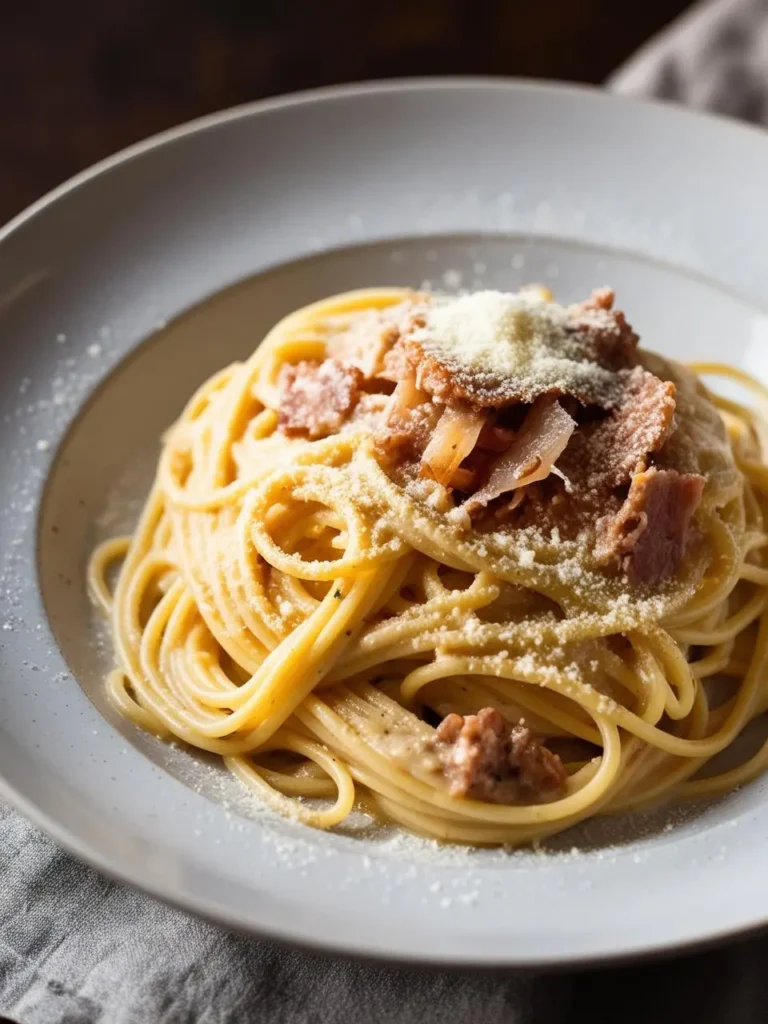
Traditional Roman Carbonara is a classic Italian pasta dish. It typically consists of spaghetti, guanciale (cured pork cheek), eggs, Pecorino Romano cheese, and black pepper. This dish is known for its creamy texture, which comes from the emulsification of the eggs and cheese.
Making Roman Carbonara is quite simple. I appreciate how quick the preparation and cooking are.
Here are the basic steps:
- Cook spaghetti in salted boiling water until al dente.
- While the pasta cooks, dice about 150 grams of guanciale and sauté it in olive oil until crispy.
- In a bowl, beat 3 large eggs and mix in 100 grams of grated Pecorino Romano cheese.
- Once the pasta is cooked, reserve some pasta water, then drain it.
- Add the hot pasta to the guanciale, mixing well. Remove from heat.
- Quickly add the egg and cheese mixture, stirring to create a creamy sauce. Add reserved pasta water as needed for consistency.
- Serve immediately with extra cheese and black pepper.
This dish captures the essence of Roman cuisine and is a favorite for many. The key is to use quality ingredients for the best flavor.
2. Creamy Mushroom Carbonara
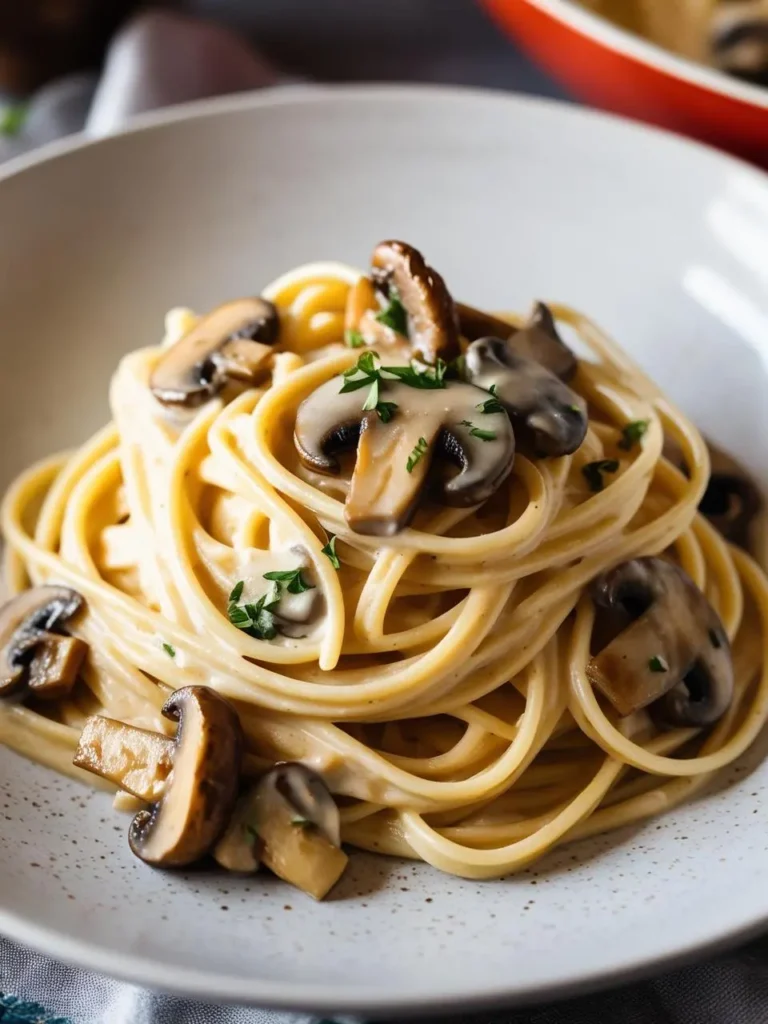
Creamy Mushroom Carbonara is a delightful twist on the classic Italian dish. This version includes mushrooms for added flavor and texture. The creamy sauce makes it rich and satisfying.
I find it easy to prepare, even for beginners. The ingredients are simple and usually readily available.
To make this dish, follow these steps:
- Cook 8 ounces of pasta according to the package instructions.
- In a pan, heat 2 tablespoons of olive oil over medium heat.
- Add 1 cup of sliced mushrooms and cook until soft, about 5 minutes.
- In a bowl, mix 1 cup of heavy cream, 1 cup of grated Parmesan cheese, and pepper to taste.
- Drain the pasta and add it to the pan with mushrooms.
- Pour the cream mixture over the pasta and stir until well combined.
This recipe is perfect for a quick dinner or a special occasion. The combination of mushrooms and creamy sauce makes it a comforting choice.
3. Vegan Carbonara with Peas
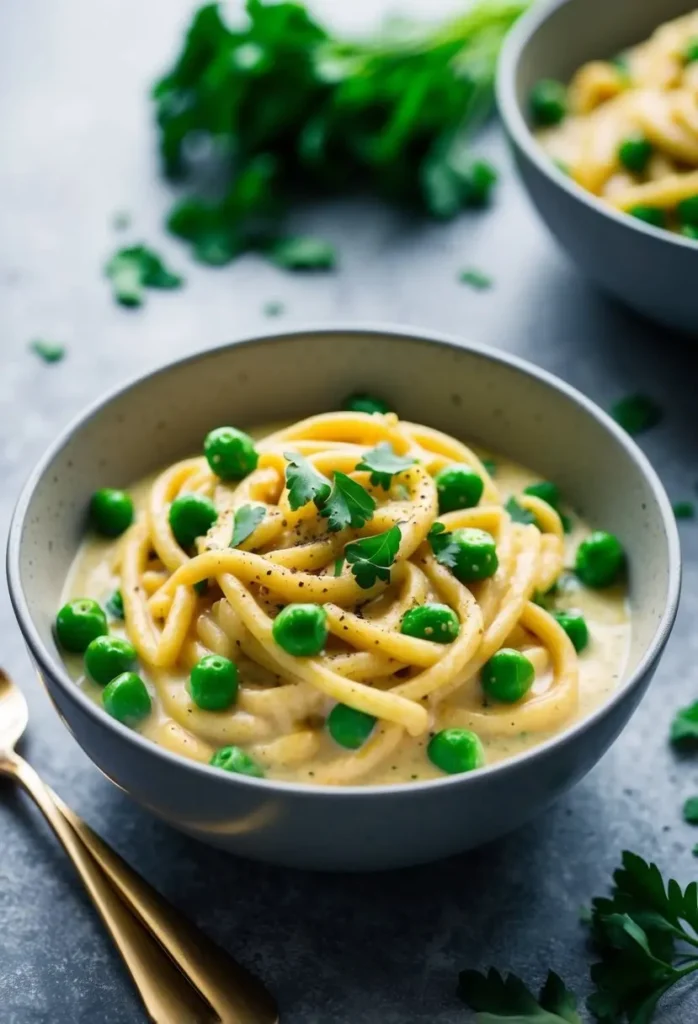
Vegan carbonara with peas is a delicious twist on the traditional recipe. It uses plant-based ingredients to create a creamy, flavorful dish. I find it a simple meal to make, perfect for busy days.
To start, gather your ingredients. You’ll need pasta, frozen peas, cashews, garlic, nutritional yeast, and vegetable broth. Soak the cashews in water for at least 30 minutes. This step helps create a smooth sauce.
- Cook the pasta according to package instructions.
- While the pasta cooks, blend the soaked cashews, garlic, nutritional yeast, and vegetable broth in a mixer until smooth.
- Drain the pasta and return it to the pot.
- Stir in the blended sauce and add the peas.
- Heat gently for a few minutes until warm.
This dish is light yet satisfying and takes under 30 minutes to prepare. I enjoy its creamy texture and how the peas add a pop of color and sweetness. It’s a great option for those looking for a quick vegan meal.
4. Shrimp and Bacon Carbonara
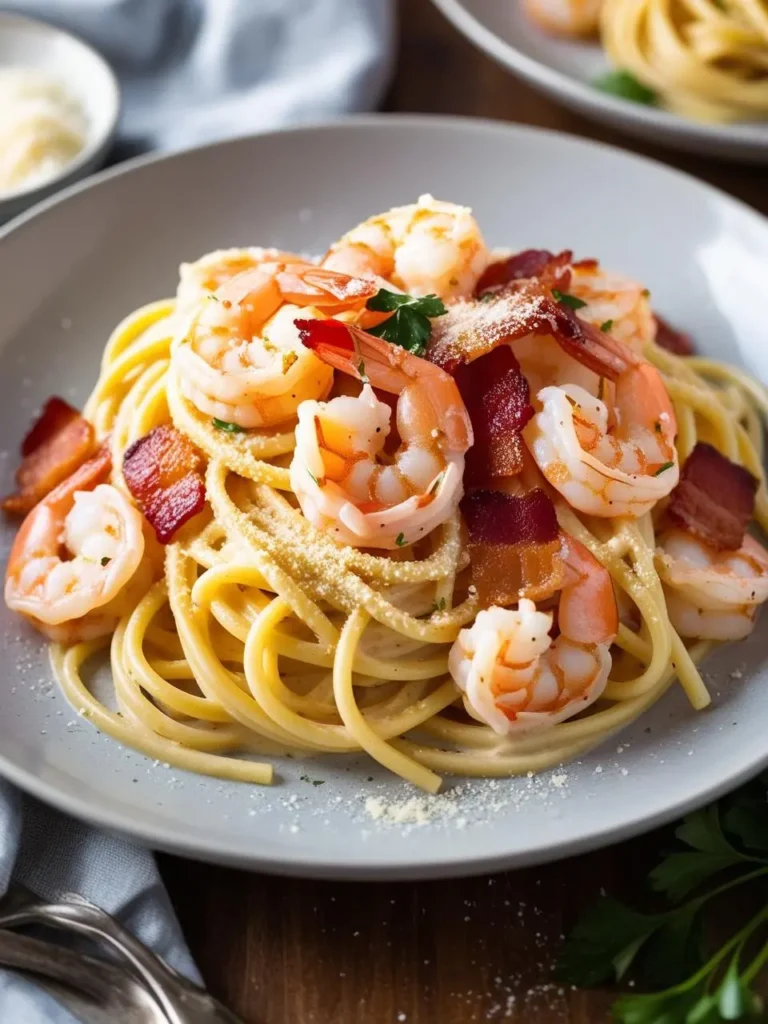
Shrimp and Bacon Carbonara is a delicious twist on the traditional Italian dish. It combines the rich flavors of crispy bacon with tender shrimp in a creamy sauce. The dish is simple to make and perfect for a weeknight dinner.
To prepare this dish, I start by cooking pasta until al dente. Usually, I prefer spaghetti or fettuccine, which holds the sauce well.
Next, I cook diced bacon in a skillet until it’s crispy. Once done, I remove the bacon and add shrimp to the same pan. I cook the shrimp until they turn pink, which takes about 2-3 minutes.
While the shrimp are cooking, I whisk together eggs, grated Parmesan cheese, and black pepper in a bowl. This mixture will create the creamy sauce.
Once the pasta is ready, I mix it with the bacon and shrimp. Then, I quickly stir in the egg mixture off the heat. This helps the sauce thicken without scrambling the eggs.
Finally, I serve my Shrimp and Bacon Carbonara immediately, garnished with extra cheese and parsley if I like. It’s a comforting meal that’s quick and satisfies my taste for something rich and savory.
5. Chicken Carbonara with Spinach
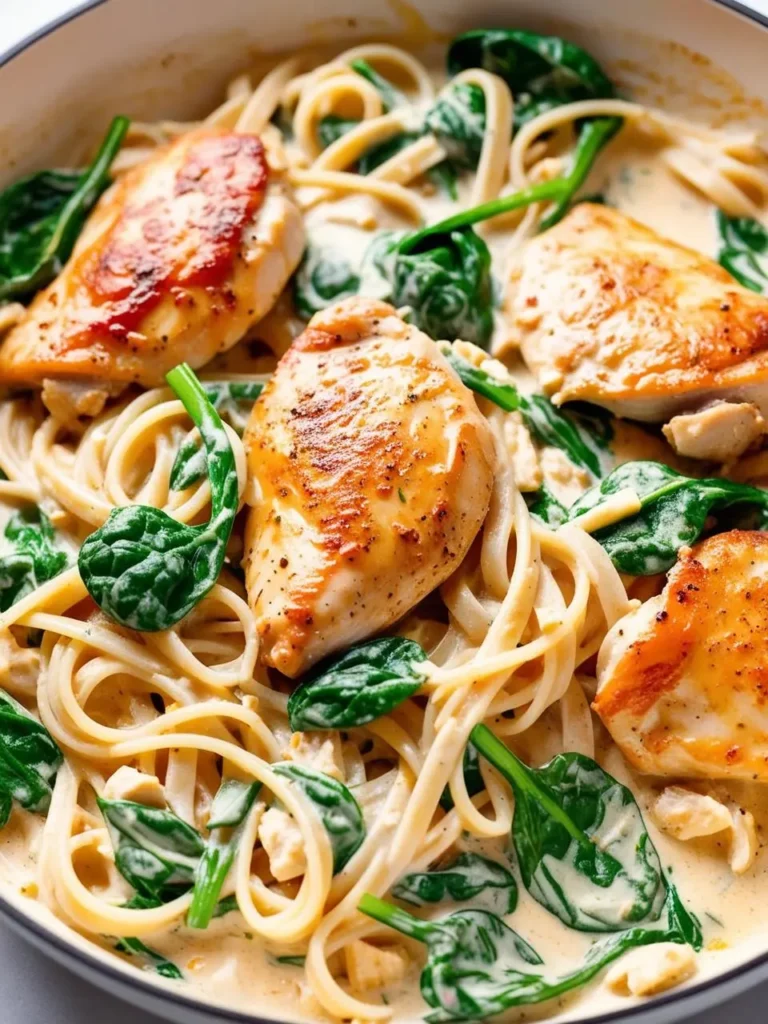
Chicken Carbonara with Spinach is a delicious twist on the classic dish. It combines tender chicken, creamy sauce, and nutritious spinach for a satisfying meal. The creamy sauce is made with eggs and cheese, giving it a rich flavor.
I find this recipe easy to make, even for beginners. It requires only a few ingredients and doesn’t take much time to prepare.
Here are the steps to make it:
- Cook 8 ounces of pasta according to package instructions.
- In a pan, cook 1 pound of diced chicken breast until browned.
- Add 2 cups of fresh spinach and cook until wilted.
- In a bowl, mix 2 eggs, 1 cup of grated Parmesan cheese, and black pepper.
- Drain the pasta and combine it with the chicken and spinach.
- Remove the pan from heat, and stir in the egg mixture quickly to create a creamy sauce.
This dish is perfect for a quick weeknight dinner or a cozy weekend meal. Enjoy!
6. Spicy Sausage Carbonara

Spicy Sausage Carbonara is a delightful twist on the traditional Italian dish. It features spicy sausage, which adds a bold flavor to the creamy sauce. This version combines heat with the comforting taste of carbonara.
I find this recipe easy to make, even for beginners. With just a few ingredients, you can create a satisfying meal.
Here are the simple steps:
- Cook the Pasta: Start by boiling water and adding 12 ounces of spaghetti. Cook until al dente, about 8-10 minutes.
- Prepare the Sausage: While the pasta cooks, heat 8 ounces of spicy sausage in a pan. Crumble it as it cooks until browned.
- Mix Eggs and Cheese: In a bowl, whisk together 2 eggs and 1 cup of grated Parmesan cheese. Set aside.
- Combine: Once the pasta is ready, drain it and add it to the sausage. Remove from heat, then quickly mix in the egg and cheese mixture.
- Serve: Add black pepper to taste and serve immediately.
This Spicy Sausage Carbonara is flavorful and perfect for a quick dinner.
7. Garlic Parmesan Carbonara
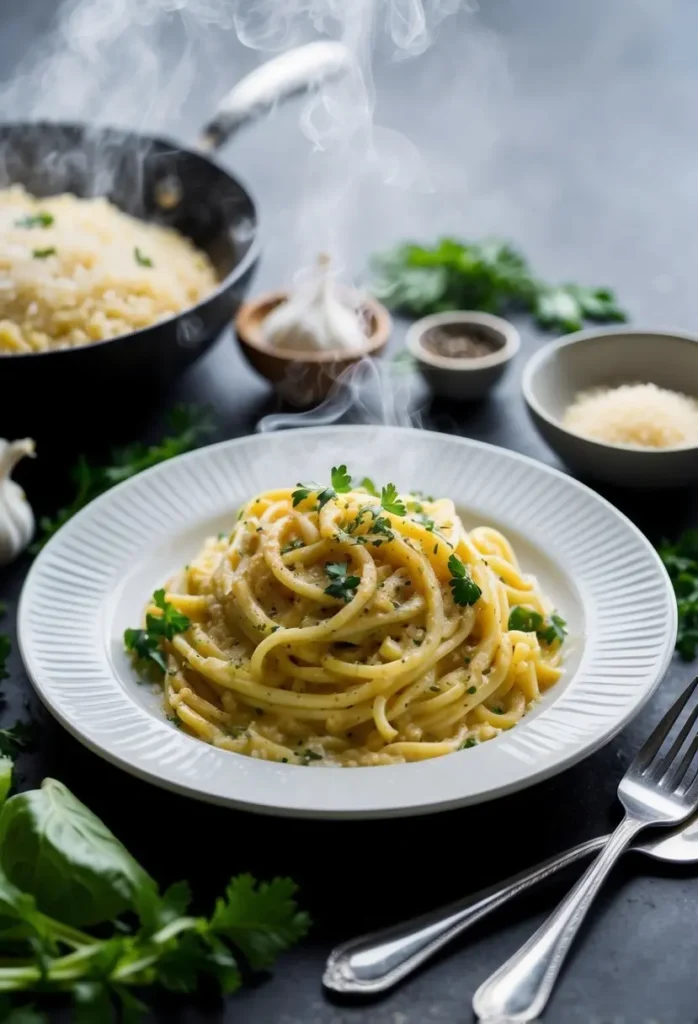
Garlic Parmesan Carbonara is a delicious twist on the classic Italian dish. It features rich flavors of garlic combined with the creamy texture of Parmesan cheese. This version adds a savory depth that I find really appealing.
Making this dish is simple and quick. I usually prepare it in about 20 minutes, making it a great option for weeknight dinners.
Here’s how I do it:
- Cook 8 ounces of spaghetti in salted boiling water until al dente.
- In a skillet, melt 2 tablespoons of butter over medium heat.
- Add 3 minced garlic cloves and sauté for 1-2 minutes until golden.
- In a bowl, whisk together 2 eggs, 1 cup of grated Parmesan, and black pepper.
- Drain the pasta, reserving some water.
- Quickly mix the hot pasta with the garlic butter.
- Pour the egg and cheese mixture into the pasta, stirring quickly to create a creamy sauce.
- If the sauce is too thick, add a little reserved pasta water to reach the desired consistency.
This recipe brings a flavorful touch to the classic carbonara while keeping it easy and enjoyable to make.
8. Carbonara with Truffle Oil
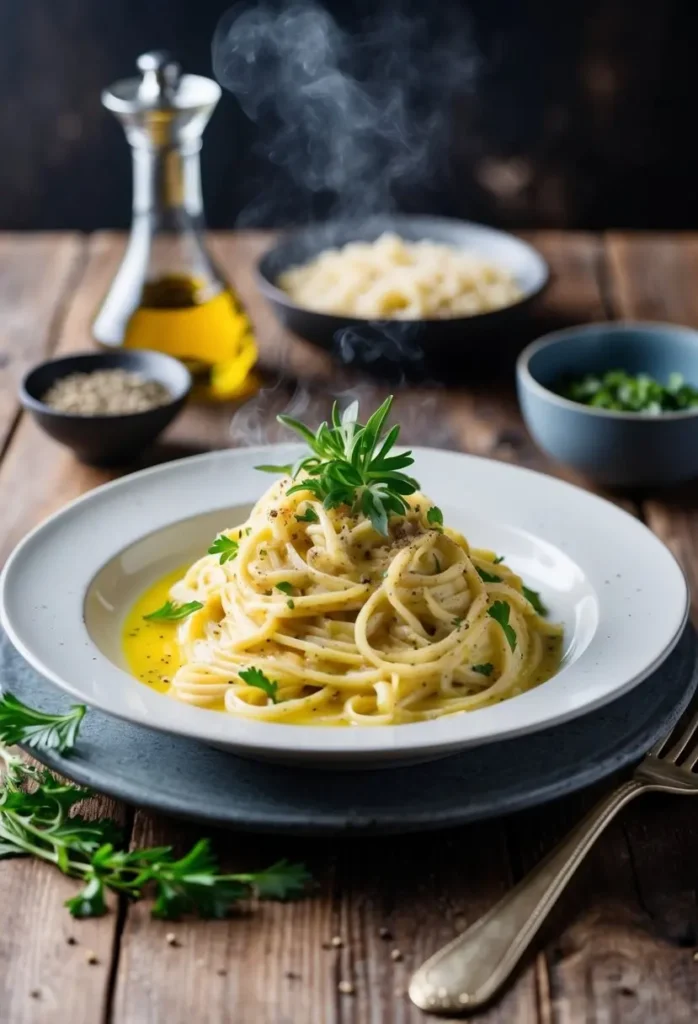
Carbonara with truffle oil is a rich twist on the classic Italian dish. The truffle oil adds a luxurious flavor that enhances the creaminess of the sauce. This dish is surprisingly easy to make at home.
To prepare this recipe, I follow these simple steps:
- Cook the Pasta: Boil your choice of pasta, like spaghetti or fettuccine, according to package instructions until al dente. This usually takes about 8-10 minutes.
- Prepare the Sauce: In a bowl, mix together 2 large eggs, 1 cup of Parmesan cheese, and a pinch of salt and pepper.
- Cook the Pancetta: In a skillet, cook 100 grams of pancetta over medium heat until crispy, about 5 minutes.
- Combine: Drain the pasta, reserving some of the water. Quickly mix the hot pasta with the pancetta and then incorporate the egg mixture. Stir well to create a creamy sauce.
- Finish with Truffle Oil: Drizzle 1-2 tablespoons of truffle oil over the pasta and toss to combine.
This dish is a delightful blend of flavors and can be ready in about 20 minutes. Enjoy the unique taste of truffles in a comforting carbonara!
9. Keto Zoodle Carbonara

Keto Zoodle Carbonara is a low-carb twist on the classic carbonara. It substitutes traditional pasta with zucchini noodles, or “zoodles,” making it a great option for those following a ketogenic diet. This dish is simple to prepare and packed with flavor.
To make this recipe, I usually start with these steps:
- Spiralize 2 medium zucchinis into noodles.
- Cook 4 oz of pancetta or bacon in a pan until crispy.
- Whisk together 2 large eggs and 1/2 cup of grated Parmesan cheese in a bowl.
- Add the zoodles to the pan with pancetta and sauté for about 2 minutes.
- Remove the pan from heat and mix in the egg and cheese mixture quickly, stirring to create a creamy sauce.
I finish with salt, pepper, and extra cheese if desired. This dish is both satisfying and healthy, offering the creamy goodness of carbonara without the carbs.
What Are the Origins and Authenticity of This Dish?
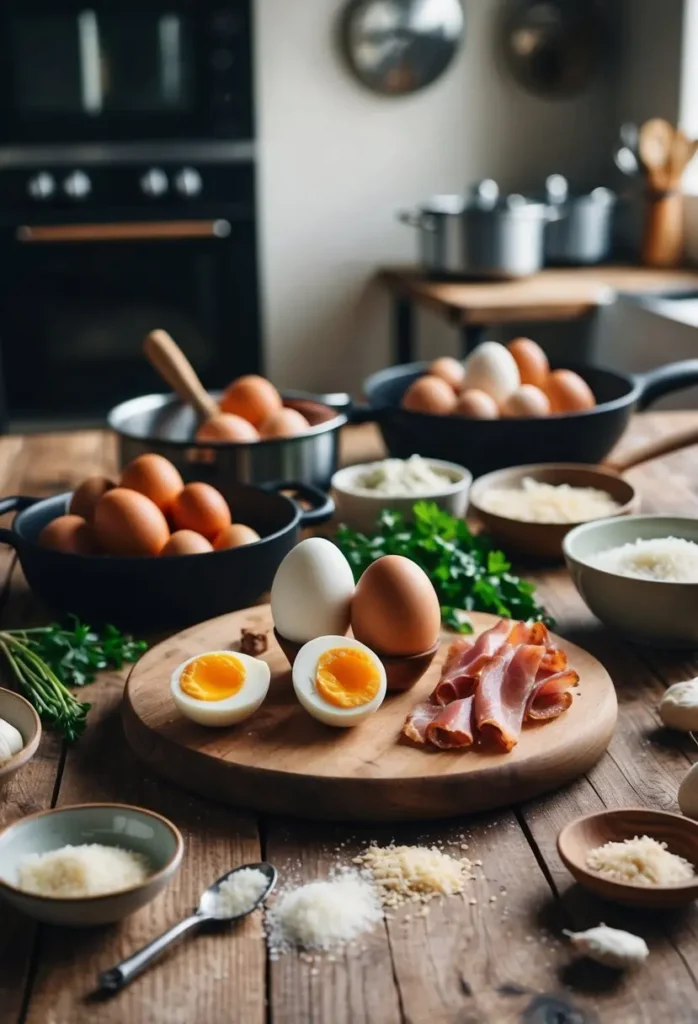
Exploring the origins of carbonara reveals its historical roots and the significance of its ingredients. Understanding both aspects helps appreciate this classic dish.
What Is the Historical Background of the Dish?
Carbonara is believed to have originated in the Lazio region of Italy, particularly in Rome. Its exact beginnings are unclear, with several theories. One popular belief is that it was created by Italian coal miners, known as “carbonari,” who needed a hearty meal. Another theory suggests that American troops in Italy during World War II adapted the dish using local ingredients.
The dish became popular in the mid-20th century. It is not just a meal but a representation of Italian culinary tradition, focused on simplicity and quality. Many Italian families have their unique recipes passed down through generations, showcasing a personal connection to this beloved dish.
What Are the Traditional Ingredients?
Carbonara relies on a few key ingredients that define its flavor. The main components are:
- Pasta: Typically, spaghetti or rigatoni is used.
- Pecorino Romano: This hard cheese adds a distinctive salty flavor.
- Guanciale: Cured pork cheek or jowl is essential for authenticity. Some may use pancetta as a substitute.
- Eggs: Fresh egg yolks create a creamy sauce when combined with hot pasta.
These ingredients blend to create a dish that is rich yet simple. Each element contributes to carbonara’s unique taste and texture. The focus on quality ingredients ensures an authentic experience that reflects Italian cooking values.
What Are the Techniques and Tips for Cooking This Dish?
When making carbonara, there are specific techniques that can enhance the dish. Understanding these can help prevent mistakes and ensure a creamy texture that elevates your recipe.
How to Avoid Common Cooking Mistakes?
One of the biggest mistakes I see is overcooking the pasta. It’s essential to cook it al dente, as it will continue to cook slightly when mixed with the sauce. To get this right, taste the pasta a minute or two before the package indicates it’s done.
Another common error is adding cream. Traditional carbonara relies on eggs and cheese for creaminess. Adding cream alters the classic flavor.
Finally, be cautious with the heat when mixing hot pasta and egg. Too much heat can scramble the eggs rather than create a smooth sauce. Remove the pan from direct heat before combining ingredients.
How to Achieve the Perfect Consistency?
To achieve the perfect consistency, I focus on the temperature of the ingredients and timing. First, I whisk the eggs and cheese together beforehand to create a smooth mixture.
When the pasta is cooked, reserve some pasta water before draining. This starchy water is invaluable for adjusting the sauce’s consistency. If the sauce is too thick, I gradually add the reserved water until it reaches my desired texture.
I also recommend tossing the hot pasta with the egg mixture quickly. The heat from the pasta should gently cook the eggs, creating a creamy sauce without scrambling them. Adjust the final consistency with additional cheese and pasta water as needed.
How Has This Dish Been Reimagined in Modern Times?
Carbonara has evolved significantly, leading to various adaptations of the traditional recipe. Today, cooks experiment with different proteins and innovative ingredients, expanding this classic dish’s appeal. Below are notable trends in modern carbonara preparations.
What Are the Variations Using Different Proteins?
While pancetta and guanciale are the traditional meats used in carbonara, many chefs now incorporate other proteins. Popular alternatives include chicken, shrimp, and even vegetarian options.
- Chicken Carbonara features sautéed chicken breast, providing a leaner choice while still delivering rich flavors.
- Shrimp Carbonara adds a seafood twist, where plump shrimp are cooked into the sauce, creating a deliciously creamy dish.
- Vegetarian Carbonara often uses mushrooms or smoked tofu for texture and flavor, appealing to those who avoid meat.
These variations showcase the versatility of carbonara and invite new tastes while honoring the essence of the original dish.
What Are Some Innovative Twists and Additions?
Cooks increasingly introduce unique ingredients that enhance the classic carbonara flavor. Some of these twists include:
- Truffle Oil: Adding a drizzle of this oil elevates the dish by introducing earthy notes.
- Lemon Zest: A touch of lemon zest brightens the flavors and balances the richness of the sauce.
- Peas or Spinach: Incorporating these greens offers color and nutrition, making the dish feel lighter.
These creative additions not only enhance the flavor profile but also appeal to modern palates looking for exciting new versions of traditional favorites.
